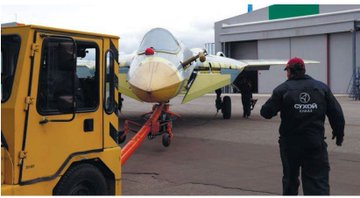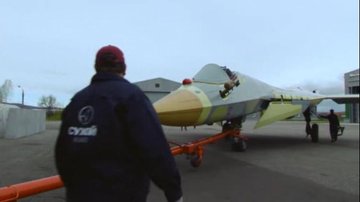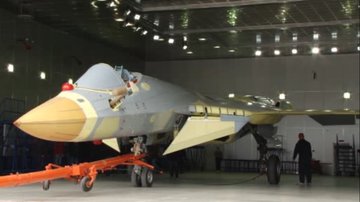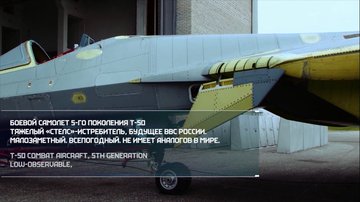



 |
|
|||
|
|
|
|
| No, The Su-57 Isn't 'Junk: |
| 送交者: 2018年05月27日05:02:21 于 [世界游戏论坛] 发送悄悄话 |
|
|
No, The Su-57 Isn't 'Junk:' Six Features We like On Russia's New FighterThe Su-57 is not an F-22, it's not meant to be, but it packs some novel attributes to offset what it lacks in stealth, at least to a limited degree.BY TYLER ROGOWAYAPRIL 30, 2018
TYLER ROGOWAYView Tyler Rogoway's Articlestwitter.com/Aviation_Intel Russia’s 5th generation fighter aircraft, formerly known as the T-50 and now officially named the Su-57, has been in the news a lot lately. India’s decision to finally walk away from the joint program could be a catastrophic blow to the jet’s future, which followed an abortive deployment to war-torn Syria late last February. Russia’s inability to afford decent sized production lots of the new jets and the aircraft’s ongoing engine saga also have taken their toll on the program. And above all else, the aircraft’s degree of low-observability (stealthiness) has long been in question, as it lacked many of the key features that define modern stealth fighters. But none of this conclusively means the Su-57 doesn’t have some redeemable qualities and features that are worth pointing out. IT'S NO SURPRISE INDIA FINALLY DITCHED ITS STEALTH FIGHTER PROGRAM WITH RUSSIABy Joseph TrevithickPosted in THE WAR ZONERUSSIA ADMITS SU-57S WERE IN SYRIA BUT CLAIMS THEY LEFT AFTER JUST TWO DAYSBy Joseph Trevithick and Tyler RogowayPosted in THE WAR ZONERUSSIAN SU-25 ALMOST HITS US F-22 DURING INTERCEPT OVER SYRIA, BUT IS THERE MORE GOING ON?By Joseph TrevithickPosted in THE WAR ZONERUSSIA ROLLS OUT NEW TU-160M2, BUT ARE MOSCOW'S BOMBER AMBITIONS REALISTIC?By Joseph TrevithickPosted in THE WAR ZONEF-22 RAPTORS HAVE INTERCEPTED RUSSIAN SU-35S NEAR ALASKA FOR THE FIRST TIMEBy Joseph TrevithickPosted in THE WAR ZONE To some degree, the T-50/Su-57 is a misunderstood aircraft. The jet's lack of high-end low-observable design features doesn't mean it is irrelevant or even ineffective. Sukhoi designers have taken a 'balanced' approach to low-observability, whereby the aircraft's reduced radar signature from certain aspects becomes just another feature to be weighed against other design priorities. This very well may have been a necessity due to lack of stealthy materials science, manufacturing, and design expertise, but none-the-less the outcome is the same. I have discussed how standoff weaponry has come into play in this equation as well, but other features have also been designed into the airframe with an apparent self-awareness of the fact that the aircraft will not be able to compete with U.S or even Chinese counterparts in terms of stealth alone. And considering how Russia's armed forces are organized and the battle doctrine behind that organization, being able to pierce deep into the most sophisticated integrated air defense networks during some sort of expeditionary operation isn't a top priority anyway. Pictures of the 9th PAK FA T-50 airframe have emerged, will be interesting to see if this flies soon #Russia #Sukhoi I get asked a lot about the Su-57s level of 'stealth' in comparison to other fighter aircraft. From years of looking into this, and talking with countless people in the defense-aerospace field about their thoughts on the design, I would handicap the Su-57 as something between an International Roadmap Super Hornet or Silent Eagle and China's J-20, with it being closer to the former than the latter. But once again, stealth is just one ingredient of a complex cocktail that makes up an advanced fighter's overall capabilities set and ability to survive in various combat situations. Static tests of T-50 mock-up (c) A.Erashov v @saidpvo With all this in mind, here are five features we like on the Su-57, some of which are tailored to help overcome its lack of extreme signature reduction, at least to a certain degree. Side Facing Cheek-Mounted RadarsThe Su-57 has a feature that was long-promised for the F-22 but as of yet, has never been delivered—side-facing radars mounted below the cockpit on aircraft's 'cheeks.' These active electronically scanned array (AESA) X-band radars supplement the aircraft primarily nose-mounted X-band N036 Byelka (Squirrel) AESA radar. Supposedly these secondary radars have roughly a third of the transmit-receive modules as the jet's main radar. You can clearly see the side radar aperture below the 'chine line' under the aerial refueling probe. At first glance, the utility of these radars is clear—they provide a far greater sensor field of view and thus enhance situational awareness for the Su-57's pilot. But beyond this the most basic of advantages, they allow the Su-57 pilot to execute a key tactic better than nearly any other fighter around. This tactic is usually referred to as "beaming." Beaming is when a fighter turns 90 degrees away (perpendicular) to an enemy’s pulse doppler radar array. Because these types of radars use doppler shift to gauge a target’s relative velocity, and as such, they filter low relative velocity objects, like ground clutter, the beaming fighter, which is not moving towards or away from the enemy radar much, can enter the enemy radar’s 'doppler notch.' This blind spot is where the radar’s velocity gate, which acts like a filter, sees a target at low enough relative motion from its perspective that it discounts it. So even though the enemy fighter may be moving at 500 mph, the right angle to the radar makes it only detect small amounts of closure. As a result, it throws this information out as it would a mountaintop. This is an especially useful tactic when the radar is positioned at a higher altitude than the beaming aircraft, and trying to lock up its target in a look-down-shoot-down scenario where ground clutter is prevalent. The issue is that with a typically fixed AESA radar or mechanically scanned array, pulling off a beaming maneuver means the fighter doing so will lose its radar picture of the enemy it is trying to evade. Without third-party sensors feeding this data to the beaming fighter via data-link, its pilot will become blind to the tactical situation when it matters most. But what's worse is that any radar-guided missiles that have been fired from the now beaming fighter will not be able to receive mid-course updates, and thus those missiles' probability of kill will plummet, especially if fired off initially at long-range. So fighters without cheek arrays, or novel swashplate like designs like those found on SAAB's JAS-39E/F Gripen and eventually on the Typhoon, and absence of engagement quality tracks provided by third-party sensors via data-link, the launching fighter will either have to take a more acute and less effective beaming angle in order to continue to update their missiles with their radar, or they will have to forget about updating them altogether. Advanced AESA radars that are highly sensitive and run complex software have lessened the impact of beaming as a tactic to a limited degree. But it is still considered relevant, especially against opponents without high-end networking and surveillance support capabilities. Onboard radar stations of T-50 (PAK FA) Thanks @saidpvo via @KRETRussia Considering the Su-57s lack of advanced stealth, you can see why having dedicated cheek arrays can be very useful as it can lower its detectability using extreme beaming tactics, especially at long ranges, while still actively guiding its missiles to its target. Once again, advanced networking capabilities, especially those used by the U.S. and its allies, can lessen the effectiveness of beaming and notching in a densely surveilled battlespace that includes the presence of airborne early warning aircraft, surface and ground-based radars, and other fighter aircraft all feeding their information into a common picture that is distributed via data-link. But Russia doesn't benefit from this level of dynamic connectivity, nor do many of its potential adversaries. So including cheek mounted arrays on the Su-57 so that it can maintain situational awareness and targeting capabilities while beaming without external help makes a lot of sense. The Su-57 is also said to incorporate L-band radar arrays blended inside its large maneuvering leading edge extensions. These radars are more for target discrimination and identification than anything else. The aircraft also has another X-band radar array in its 'stinger' tail for enhanced situational awareness, and possibly for future targeting with extremely agile 'lock-on after launch' missiles as well. Su-57's tail-mounted radar. Also notice the sizeable weapons bay gap. It's also worth noting that AESA arrays can also be used to execute pinpoint electronic attacks. Theoretically, a fighter's radar system could employ these electronic warfare tactics while attacking another aircraft, or while under attack. Being able to do so even at oblique angles without changing nose position could be beneficial, as well. With that in mind, the Su-57 could be a powerful electronic warfare tool, if not today, then possibly the future. It's worth noting that even while beaming, putting out any radar energy could potentially give away your position. But the Su-57 has a solution for that as well. Infrared Search and TrackThe Su-57 sports an advanced 101KS 'Atoll' infrared search and track sensor in the traditional position on Russian fighters—installed atop the aircraft's nose, near its windscreen. Although this placement clearly hurts the Su-57s radar signature where it matters most—in the forward hemisphere—an IRST is among the best technologies available for detecting and engaging stealth targets from afar. I recommend you read all about IRSTs and how they are used in air combat in this past feature of mine to get a healthier understanding of the unique capabilities they bring to an aerial fight. Viktor Bondarev, Russian Aerospace Forces(VKS) Commander: First stage of #PAKFA tests to be completed in December'17function.mil.ru/news_page/coun… Once #PAKFA enters series production it is to be officially designated as Su-57- radars & EO diagram ©Piotr Butowski bmpd.livejournal.com/2760067.html pic.twitter.com/ss7RIbphHN An IRST can also be used to provide targeting information to a fighter's missiles in-flight, even while that jet is beaming. Above all else it allows the Su-57 to operate and persecute targets while staying electromagnetically silent (giving off no radio emissions), which is just as big of a deal these days as being hard to detect on radar. It also is immune to the effects of electronic warfare. Modern combat aircraft have the ability to detect, classifying, and even geolocate enemy emissions. Low probability of intercept (LPI) radar modes can drastically help with remaining untrackable while still giving off some emissions, but LPI is a broad term and not all aircraft with LPI radars have the same abilities to stay undetected while also actively using those radars in combat situations. The Su-57's 101KS-V IRST is mounted where it is found traditionally on Russia fighters and not the best spot for low observability. The ball does rotate rearwards in when not in use. But an infrared search and track system can allow for creative tactics to be used as well that can surprise the enemy and exploit holes in their game plans. But once again, above all else, it gives the Su-57 some capability to detect and even engage the stealthiest aircraft around even while they are not giving off any radio emissions. Although getting close enough to do so before getting killed by a long-range air-to-air missile is still a major limiting factor of these systems as they have limited range and are impacted by atmospheric conditions. It's also worth noting that this system could also provide an image of the aircraft beyond-visual-range, which can help with being able to take the first shot under tight rules of engagement. The Super Hornet's IRST21 is integrated into the forward part of a centerline fuel tank. The system will be fielded before the end of the decade. On F-15Cs it will be flown in a Legion Pod and the Talon HATE pod. An advanced IRST was also promised for the F-22 as part of the Advanced Tactical Fighter Program but it was axed due to cost-cutting measures as the program moved from prototype to a production configuration. Today, the Navy and the USAF are on the cusp of procuring podded IRST systems for their 4th generation fighters. The F-35 can use its electro-optical targeting system (EOTS) for long-range aircraft identification and some limited IRST-like functions but is not comparable to a dedicated sensor. Directional Infrared Countermeasures SystemLike the F-22, the Su-57 has a number of missile launch detector apertures scattered around the aircraft but the Su-57 also has turrets that fire modulated laser beams at an incoming missile's seeker to blind it and throw it off course. The Russian system used on the Su-57 is part of the larger N101KS electro-optical suite that includes the missile launch detector systems, IRST, and the DIRCM turrets mounted dorsally behind the cockpit and ventrally under the cockpit. The upper and lower 101KS-O DIRCM bubbles can be seen in this image. Not all T-50s/Su-57s have been equipped with this system yet, but it is a core feature of the design. This soft-kill system has been seen mounted on a number of Su-57 prototypes, and if it works as advertised, it can go a long way to defending the aircraft against advanced infrared-homing—also referred to as 'heat seeking'—missiles. This includes the shoulder-fired man-portable air defense system (MANDPAD) variety and the air-to-air variety. DIRCM systems, which have been in use by the U.S. military and its allies for nearly two decades, are largely understood to be more effective against advanced imaging infrared seekers than expendable countermeasures like flares or BOL-IR decoys. Canopy inlets that were initially 6(3 each side) became 2 around Mar'15,then went back to streamlined 6 in late'15. Note Atoll EOCM' 101KS-O pic.twitter.com/s4jziSQdj0 Russia has installed fairly clunky DIRCM systems on some of its helicopters and airlift fleet, but nothing as miniaturized as seen on the Su-57, which rivals U.S. systems in its compactness. But in Syria, in particular, Russia fear of MANPADs is potent, and rightfully so. Having a DIRCM system on a jet fighter is largely unprecedented. The concept certainly exists, but currently, these self-protection suites are largely installed on transport aircraft and helicopters as defenses against MANPADs, not against air-to-air missiles. And denying attacks by air-to-air missiles is definitely an intent for the Su-57's DIRCM system as, once again, it has a turret on top of the jet as well. So in this sense, the Su-57 is something of a pioneer in this regard and this type of system is also likely a hedge against future long-range infrared-guided and dual-model air-to-air missiles. Austere Airfields WelcomeRussian fighters, even advanced and stealthy ones apparently, are designed with ruggedness in mind. Beyond featuring heavy-duty landing gear and big tires, along with mudguards over their nose-wheels, MiG-29 derivatives even have intake doors that close off airflow from directly in front of and below the jet during taxiing operations. Some Su-27s had screens that worked in a similar fashion. The Su-57 doesn't have any intake barriers that we have seen, but it does have the robust landing gear, including mudguard, that is reminiscent of its predecessors. The Su-57 may be the highest technology Russia has to offer, but it retained the hardy landing gear of its predecessors. If you have ever seen Russian airfields—at least some of them—the need for tough landing gear isn't surprising. But this can also come in really handy when executing dispersed operations to airfields and roadways that don't have the luxury of a small army of sweeper vehicles. In this regard, many American aircraft fall short, and that's somewhat of an issue considering the Pentagon is becoming ever more focused on austere and highly distributed aircraft operations throughout the Pacific during a crisis. And this initiative includes pushing more fragile jets like the Raptor, and even Reaper drones, in small groups to far-flung island airstrips. 3D Thrust Vectoring:We have discussed how thrust vectoring has limited utility throughout most of a fighter's flight envelope—with it being most useful at very high altitudes and speeds, or in the near or post-stall regime—but it's still a cool feature to have, especially if other advantages remain out of technological reach. Considering the tradeoffs in design and capabilities the Su-57 represents, being able to outmaneuver the enemy within visual range is still a positive, especially considering it may not be able to avoid a fight like some of its more stealthy counterparts. 3D thrust vectoring at lower speeds and altitudes allows for some incredible acrobatic feats, but really it has drastically diminishing returns, and can even be dangerous to fully utilize during anything but a one-on-one within visual range fight. Ending up in a totally depleted energy state may get the kill, but if other fighters are nearby, and they usually are, it probably means you get to die too. Nonetheless, it's there on the Su-57 and it's the first time 3D thrust vectoring has integrated included into a stealthy fighter. #Russia's Sukhoi Su-57 new generation second stage engine codenamed #Product30 was unveiled to the public for the first time #avgeek Unique Weapons Bay ConfigurationThe Su-57 has a unique tandem weapons bay. We still don't know much about it conclusively, but it seems as if four to six medium-range air-to-air missiles can be carried at one time internally. Depending on the depth of the bays, it's possible fewer, larger weapons could be carried instead—such as guided bombs or air-to-surface standoff missiles—but we will have to wait for more official information and photo evidence in order to discuss this further with confidence. The jet also supposedly features a pair of short-range air-to-air missile bays located under its wing-roots. These triangular, canoe-like structures are said to open like a clamshell to expose the missile inside during combat. Once again, to our knowledge, there are no actual photos of this system being used, and it's a little puzzling trying to figure out how a missile like the R-73 could fit in there. Maybe a specialized missile with a smaller diameter profile is intended for those bays sometime in the future. The #VictoryDay Parade rehearsals in Zhukovsky keep delivering magnificent aviation photos, especially those of the Sukhoi Su-57 jets that will for the first time take part in the Parade. The underbody-silhouette view of the T50-5 prototype with new livery ©Artyom Anikeev In the end, it's clear Russia has done the best it can when it comes to making up for limitations low-observable know-how by adding other capabilities that would help the Su-57 survive in a fight. And as we always like to stress, stealth is just one part of an array of measures that can collectively mean the difference between life and death in the air combat arena. Electronic warfare especially, when combined with low observability, is becoming more of a factor than ever in modern a combat. And remember, when we talk about stealth, even on just the radio frequency spectrum, we are talking about how far away a target can be detected and how far it can be engaged using a particular radar operating on a particular band while viewing a target from a particular aspect. Given the same X-band pulse doppler radar set, maybe (just for hypothetical example) a Su-27 can be detected head-on at 90 miles, while an Su-57 can be detected head-on at 35 miles while the F-22 can be detected at under ten miles. Sure that's a big disparity in performance, but that's just one aspect of a very complex air combat equation. Once again, this includes networking, the sensitivity of onboard passive sensors, standoff weapon performance, degrees of low-observability from various aspects, electronic warfare, tactics, speed, range, the persistent support aircraft like airborne early warning and control aircraft, and so much more. The cost of the aircraft itself and the quantitative advantage that may go along with it can't also be overlooked. Russia’s T-50 PAK FA fighter latest pics #sukhoi #T50 (c) A.Mishin, Alex S, A.Burtsev We don't know the exact quality and level of integration of the Su-57's sensors and mission systems, but on paper at least, no, the Su-57 isn't 'junk' at all. It represents a rather clever mix of capabilities that are tailored to Russia's more austere, less networked, air-battle doctrine, and it's more than capable of taking on enemies it's more likely to fight than some Armageddon war with the United States. That being said, with tight rules of engagement, like those over Syria, many of even its most capable opponent's abilities are rendered neutral anyway. So if Russia can continue to finance it and sort out its engine issues, the Su-57 is set to become a capable highly valued fighter that is better than anything else in the Russian Air Force's inventory. But is it an F-22? No, it isn't. And that's the problem—clearly it isn't meant to be. Yet it seems Russian officials and the Russian press constantly make claims otherwise. That's like claiming a Super Hornet is as capable in certain respects as an F-35, it simply isn't accurate and it's not really a fair comparison to make in the first place. Above all else, you have to give the Russians some credit for taking new risks with their design and incorporating innovative concepts into it, even if doing so came as a result of lacking critical low observable design knowledge and manufacturing capabilities. Contact the author: Tyler@thedrive.com |
|
|
 |
 |
| 实用资讯 | |